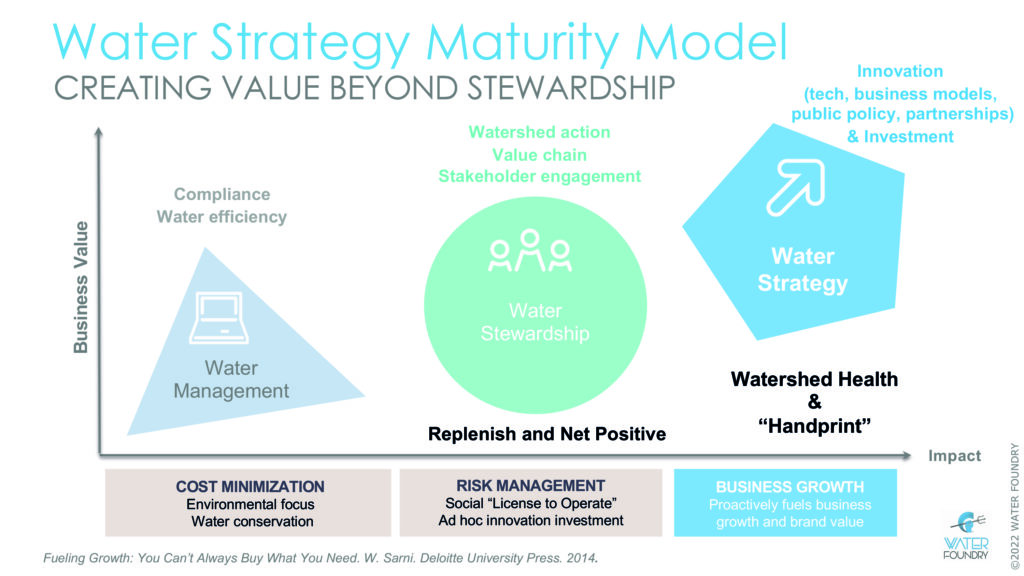Corporations are increasingly building on their water stewardship strategies to attain net-zero goals for carbon and water, improve watershed health, and operate smarter systems using innovative technology. Will Sarni and David Grant explain.
Over the past two decades, corporations have made significant progress in addressing the business, social, ecosystem, and economic challenges of water. Companies have moved from viewing water as an issue of management and regulatory compliance to responding to wider water issues, including scarcity, poor quality, inequity in access to safe drinking water, and the impacts of climate change. While regulatory compliance for water and associated management practices are the cornerstone of a corporate water strategy, they do not deliver the full value to corporations, communities, and other stakeholders.
Moving to a value chain strategy in addressing water risks has delivered benefits for businesses, communities, and ecosystems. We are now at another pivotal period as companies focus on investing in creating and maintaining healthy watersheds and more actively investing in innovative technology to solve water issues.
Net positive and watershed health
Corporations adopt clear and concise language for their water strategies to mobilise stakeholders and convey the value of their commitments and investments. Two emerging areas of focus are ‘watershed health’ and achieving ‘net positive’ water goals. These strategies and focus areas provide companies with the opportunity to have an impact beyond their value chain water footprint. This strategy of investment in innovative technologies, public policy, and working with entrepreneurs has been termed a company’s ‘handprint’. This is an important change, with several companies looking at watersheds holistically and supporting the scaling of innovative digital technologies to measure water quality, quantity, supply chain performance, and productivity on a real-time basis.
Examples of companies directly investing in innovation include AB InBev, PepsiCo, and Diageo. These companies are investing in innovative digital and water treatment technologies to measure water quantity and quality on a real-time basis, along with forecasting capabilities using AI solutions and addressing complex water challenges. These initiatives focused on innovation and investment are typically led by a blend of corporate sustainability and water teams coupled with expertise from corporate ventures. Such programmes include 100+ Accelerator, which was launched by PepsiCo Labs. The 100+ Accelerator programme now includes The Coca-Cola Company, Unilever, and Colgate Palmolive. PepsiCo and Diageo have now also built sustainability and water-focused innovation strategies and programmes.
Case Study: PepsiCo
In 2021 PepsiCo announced its new pep+ sustainability strategy, a strategic end-to-end transformation with sustainability at the centre of how the company will create growth and value by operating within planetary boundaries and inspiring positive change for the planet and people.
Water stewardship forms a key part of this strategy, with the company committing to be Net Water Positive by 2030 underpinned by a robust set of goals across its operational and agricultural water use, improvement of watershed health in high-risk territories, and providing access to clean water to communities in need. Through implementing its Net Water Positive strategy, PepsiCo aims to contribute towards unlocking some of the key issues impacting water scarcity and consequently support thriving ecosystems, communities, and local economies in the territories in which they operate.
To support the delivery of these ambitious goals, the company is not only focusing on ‘lifting and shifting’ existing best practices across the company but also identifying and investing in new innovative technologies.
According to Jim Andrew, chief sustainability officer at PepsiCo: “We have just nine years to reach our ambitious 2030 Net Water Positive goals. So, there is no time to waste. We’re looking at our full value chain, from top to bottom, and asking how we can leverage the innovation and creativity that exists within our company to ensure that the water resources PepsiCo uses are better off a decade from now than they are today.”
Manufacturing footprint
PepsiCo has a large global footprint, and several of its manufacturing facilities are in regions considered as water stressed. To reduce the pressure and demand on water resources in these territories, the company has set a goal of reaching world class water use efficiency across all its high-risk water operations. To support the achievement of these goals, the company has ramped up its efforts to identify and unlock new technological advances.
The company’s Global Research & Development team has successfully proven an innovative method for condensing and treating the steam evaporated from its fryers to recover more than 50% of the water used in potato chip manufacturing lines. The energy recovered from the condensation can also be used for other manufacturing purposes, such as cooling parts of the plant or converting it to electricity and so reducing the plant’s energy needs.
PepsiCo has fully implemented this technology at its facility in Kolkata, India, where the proof-of-concept showed the approach could save approximately 60 million litres of water a year. Over the next seven years, the technology is expected to be adopted at nearly 30 potato chip manufacturing plants in high-water-risk areas. In addition to this, several other technologies are currently being trialled to increase the company’s ability to recover, treat and reuse water within its production process. Achieving this goal will result in annual savings of 11 billion litres of water per year.
Supply chain
On average, agriculture accounts for around 70% of global water consumption and is therefore an important focus area. Recognising this, PepsiCo has committed to advocating for and contributing to a measurable improvement in the health of high-water-risk watersheds where it directly sources crops, including an improvement in on-farm water-use efficiency.
Many irrigation practices currently used across the world are very inefficient. For example, countless farmers use flood or trench irrigation to bring water to their crops, which floods the field at regular intervals, losing up to 70% of the water used. Drip irrigation techniques have made significant inroads into reducing the amount of water required for crop cultivation. Taking this technology still further, Israeli-headquartered N-Drip’s high-efficiency irrigation system is powered by gravity and harnesses the water-saving benefits of high-pressure drip irrigation, but with low energy, operating and maintenance demands – making it more accessible to farmers and suitable for nearly all types of crops.
PepsiCo has piloted N-Drip’s technology in India, Vietnam, and the USA, and saw improved crop yields, reduced fertiliser usage, and 50% less water consumed compared to flood irrigation. Together, the companies aim to help farmers adopt the technology across 10,000 hectares (25,000 acres) by 2025.
Healthy watersheds
There is no doubt that significant gains have been made in understanding and implementing programmes to improve the health of water stressed basins. At the same time there are still significant data gaps in many of these watersheds. Recognising this, PepsiCo made a founding investment in the Colorado River Basin Fund, a $5 million ‘future of water’ venture capital fund focused on incubating technology solutions to address water scarcity in this critical watershed. The fund will invest in startups addressing water scarcity, quality and equitable access through technologies that help with leak detection in smart homes, real-time water quantity and quality monitoring in business-dependent watersheds, and next-generation water recycling and alternative sources. This investment aims to catalyse the development of new solutions to help improve the health of the watershed.
PepsiCo has also made significant investments in supporting collective action in water stressed basins across the world, partnering with both local NGOs and global NGOs such as WWF and The Nature Conservancy. The American West – and the Colorado River Basin in particular – is now among the world’s most water-stressed regions.
To help advance its Net Water Positive goals in this critical watershed, PepsiCo has invested nearly $2 million in two innovative partnerships.
PepsiCo’s North American businesses are partnering with the non-profit Trout Unlimited to reestablish connectivity between two segments of the Colorado River that had been blocked by the Windy Gap Reservoir near Denver, Colorado.
By constructing a mile-long channel to bypass the reservoir, the initiative is expected to restore perennial flows throughout the river, create 18 acres of new wetlands, restore 50 acres of riverside habitat, and replenish approximately 380 million gallons (1440 Ml) of water per year.
Safe water access
PepsiCo has long recognised access to water as a basic human right and has been actively expanding its activities in this area. In 2021, the PepsiCo Foundation expanded the reach of its safe water access programme by an additional eight million people. Since this initiative began in 2006, the company has helped to provide access to safe water to approximately 68 million people, with a goal of reaching 100 million by 2030. To continue to advance this goal, the Foundation is granting $1.5 million over three years to two new water stewardship programmes in Latin America and Nigeria.
Building on a decade-long, successful partnership with the Inter-American Development Bank’s Aqua Fund, the Foundation is committing an additional $500,000 to improve water access and sanitation services across Latin America, bringing the Foundation’s total investment to more than $10 million. In Nigeria, the Foundation is granting $1 million to WaterAid to support the construction of water supply and sanitation facilities and the development of programmes to promote good hygiene practices.
The path forward
Several trends are coalescing to address the 21st century challenges of water scarcity, declining quality, and the ‘threat multiplier’ of climate change. Increasing proactive engagement by the private sector in building and maintaining sustainable and resilient supply chains, watersheds and communities has triggered investments in technologies, partnerships, and increased engagement in innovations in public policy. While the private sector is not the only key stakeholder to be addressing difficult water challenges, it is in a unique position, having the advantage of a combination of speed and scale in addressing water challenges and their intersection with other critical issues such as climate change, sustainable agriculture, and access to clean water.
The path forward is to build and maintain platforms such as PepsiCo Labs and the 100+ Accelerator programmes for increased collaboration of the private sector with entrepreneurs, investors, civil society, consumers, the public sector, and NGOs. A central part of the path forward is for the private sector to accelerate the adoption of innovative technologies and business models to create a real abundance of water for economic development, business growth, ecosystem health, and social well-being. •
The authors
Will Sarni is chief executive officer of Water Foundry and the Colorado River Basin Fund
David Grant is global sustainability director for PepsiCo
More information
Water footprint versus water handprint: https://www.greenbiz.com/article/water-footprint-versus-water-handprint








